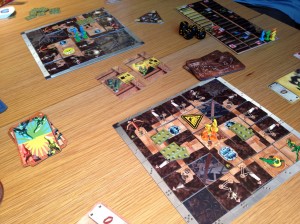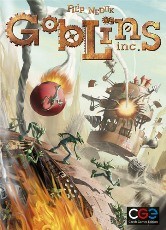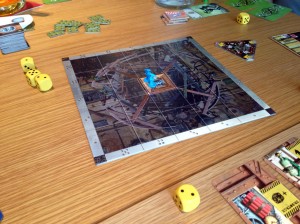Review: Goblins Inc
Posted by James (admin) on November 22nd, 2012
 In Goblins Inc, players are goblins creating giant war robots that will fight each other. First, players are placed in random teams – these teams will change after the first fight and new robots are built by these new teams for the second (final) fight. The players who build a robot that wins a fight score victory points (VPs), plus players get individual VPs for their own hidden agenda cards. Before any building takes place, players draw 7 cards from their hidden agenda deck – just before the fight, players will choose just 4 of their 7 cards which will score them VPs once the fight is over. Hidden agenda cards award VPs based on (a) destroying specific types of tiles on the opponent’s robot, or (b) specific types of tiles not being blown off of your own robot), or (c) predicting which side will win. (Yes, you can predict the opponent to win and help it happen too). The player with the most VPs after two fights is the winner.
In Goblins Inc, players are goblins creating giant war robots that will fight each other. First, players are placed in random teams – these teams will change after the first fight and new robots are built by these new teams for the second (final) fight. The players who build a robot that wins a fight score victory points (VPs), plus players get individual VPs for their own hidden agenda cards. Before any building takes place, players draw 7 cards from their hidden agenda deck – just before the fight, players will choose just 4 of their 7 cards which will score them VPs once the fight is over. Hidden agenda cards award VPs based on (a) destroying specific types of tiles on the opponent’s robot, or (b) specific types of tiles not being blown off of your own robot), or (c) predicting which side will win. (Yes, you can predict the opponent to win and help it happen too). The player with the most VPs after two fights is the winner.
For each robot fight, players first need to build their robot by adding 20 tiles to their 5×5 grid – the centre space is always the cockpit and 4 spaces (determined by a card each fight) must remain empty. Tiles show engines, weapons, decorations and armour, plus they also show the underlying bodywork too. When building, you can place tiles on any empty grid space; however, if any tile is not contiguously connected by bodywork before the fight starts then it will fall off.
Ideally the game is played with 2 teams of two players, and I’ll describe how the game plays this way. First, player A on each team draws 5 random tiles, keeps 3 and gives 2 to player A on the other team who also drew tiles. These players now add their 5 tiles to the grid. Player B then does the same, then player A again and then player B again – so both teams place 20 tiles each. To speed things up, player B in a team can start drawing tiles while player A is placing the ones they already have, and vice versa. (With 3 players, one player builds a robot on their own, and with 2 players, both players build robots solo).
After building, any unconnected tiles fall off and players pick 4 of their 7 hidden agenda cards. Now the fight starts which takes place over 4 rounds. One team member is the Pilot who determines if the robot will turn (the side facing the opponent will fire its weapons) and which side of the opponent it will attack (the opponent may turn before the attack). These actions can require engine power which is limited by the engine tiles on their robot (if these get destroyed, options can become more restricted in later rounds).
Three tactics cards are revealed (which give combat advantages such as re-rolling dice) and the Tactician (not the Pilot) on each side secretly picks which card they want. Then, they simultaneously reveal and get the card they picked, unless they both picked the same card where the team with the most unused engine power gets it and the other team gets nothing.
Next, both robots fire. Players roll dice based on the number of weapons being fired (maximum 5) plus any tactics card effects. Each column of a robot’s 5×5 grid is numbered 1-5. Dice that roll 1-5 cause 1 hit of damage to the first tile in that column (rolls of 6 are misses). Most tiles are destroyed (removed) by 1 hit (unless they have armour) and any areas that are now unconnected by bodywork fall off. The player who rolled the dice can choose the order of the hits as this can make a difference. A robot is out of a fight if it has no remaining weapons or the 4 goblin figures in the cockpit (2 per owning player) are killed; otherwise, another combat round takes place starting with new tactics cards.
When the fight is over, players reveal their hidden agenda cards and score their VPs, plus any for winning the fight.
THOUGHTS
Overall, Goblins Inc is very enjoyable and fun. The game mechanics feel fresh so the game has its own identity and stands out. Building the robot is engaging as is picking your hidden agenda cards. Selecting and passing tiles back and forth works well and, whilst you’re playing as individuals, there’s a commraderie in the teams (even when the teams change). As the robots are built of random tiles, they should be quite varied when replayed.
Shooting your opponent is highly enjoyable and seeing pieces fall off their robot is very funny indeed. There’s a definite atmosphere of anticipation to see the result of the combat rolls and their resultant damage. If you have fewer engines than your opponent (so you will lose a tie and get no card if you pick the same tactics card as them), picking your tactics card is a very entertainingly tense moment as you try to figure out what your opponent picked and think if he’s thinking what you’re thinking. So, the game is definitely compelling and fun.
The difference between a good tactics card and a bad (or no) tactics card may be a bit too great because the bonuses can make a big difference. However, I don’t mind this too much as it makes the choice of tactic card one of the most tense moments in the game. Also, you’ll find weak spots in your robot’s construction in one direction or another are almost inevitable but that’s part of the fun.
However, I found a couple of downsides with the game as a gaming experience which resulted in me feeling that I had little control over my performance. First is that it’s hard to actively maximise VPs from your hidden agenda cards. Potentially you can give your opponent tiles for which you’ll gain VPs if destroyed, and keep tiles for which you’ll gain VPs if they survive; however, this didn’t feel very influential in practice because you only give 4 tiles to your opponent (although this would be 8 if building a robot solo). Plus, giving away dangerous tiles like weapons, armour and engines because you want to score VPs if you then destroy them won’t score you many VPs when those tiles are used to pound you into dust before you get a chance. So, you’ll most likely give your opponent the weakest tiles and pick the 4 hidden agenda cards with the most potential (as you see your opponent’s finished robot before choosing).
Blasting your opponent to pieces before they do the same to you seems much more important/critical than choosing the order in which hits occur to the opponent, and rotating your robot to try to protect weak areas (as the enemy can target any side). So, your primary motivator is to destroy the opponent, rather than placing yourself at a disadvantage just to gain a few potential VPs – you’ll score lots for an intact robot and for a damaged opponent’s robot, plus your opponents will not.
The second downside is that the combat dice introduce a very large element of luck. You spend half the game selecting robot parts, placing them, considering hidden agendas and trying to get the best tactics card, but then the combat result is almost entirely down to the luck of the dice roll. Only one tactics card will let you target one dice on a specific column (if it’s available that round); otherwise, it’s all down to the dice roll.
This luck element is critical to success because if you lose weapons/engines, you won’t be able to reduce the enemy’s weapons/engines resulting in them continuing to damage you but leaving you with no response (except to litter the battle arena with your debris). If you are lucky and pound your opponent, you will knock off most of their tiles, keep your tiles and will score well for your hidden agenda cards (whilst your opponents will not).
 FINALLY
FINALLY
The downsides above don’t make Goblins Inc a bad game at all – as I mentioned it is compelling, fun and very different to other games. It is a light game too so a larger element of luck is acceptable – I just felt the luck factor was so great that I didn’t feel I could influence the outcome very much. Maybe with more plays I would find that I could affect my VPs a bit more, but I suspect it’ll be by a relatively small amount.
Whilst there are variants in the rules, I’d love to see a non-dice (or greater input) combat system. Maybe the two players simultaneously reveal cards for which columns they want to fire at – any matching ones fire, any non-matching ones are random (representing the two players fighting over the controls). Or, maybe players allocate attacks to specific columns before rolling and then there’s a 50% chance of hitting the target column and those that do not hit their intended column either hit one of the other columns or miss. These are just thoughts off the top of my head to show that I think there are other options than pure randomness.
James.
[Played with 4 players]



